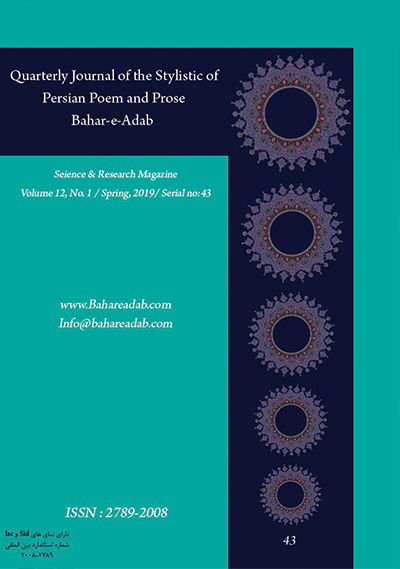- Count View : 341
- آدرس کوتاه شده مقاله: https://bahareadab.com/article_id/275
volume Number 12،
number In Volume 1،
،
issue Number 43
Content and Visual Study of Poems Composed by AbdiBeig Focusing on “Haft Akhtar” Poetry
Hanieh Sadri Majd , Ali Asghar Halabi (Author in Charge)
Abstract
Contemplating on the thinking abilities and artistic minutes of art works is a giant pace for resuscitating and identifying precious heritage of Persian literature and the authentic and enriching culture rooted in the ancient history of Iran intermingled with Islamic thoughts and mysticism.
ZeinolabedinAbdiBeigNavidiShirazi is one of the outstanding and hardworking poets during Safavid era who dealt deeply writing specimen (writing a work similar to a previous one). His literal personality and his works have not yet been considered in Iran significantly. He is well-known because of his historical works. Following the tradition of scholarism and imitation during the mentioned era, he has composed the lyric poetry “Haft Akhtar” against Nezami’s Haft Peikar and has versed seven independent and advanterous narratives orated by seven princesses of BahramGoor (Bahram V) while excerpting the king’s life. While his work cannot be displayed against Nezami’s masterpieces and artistic creation, his works can be studied and contemplated in because they contain innovations in creating themes and visualization, ethical and mystical points, social and critical approaches and indicating the mass culture. This research studies and analyzes in depth the structure of the mentioned poetry focusing on the outstanding intellectual, educational and social indicators. The second section deals explaining and identifying the visual beauties of AbdiBeig’s poem through application of rhetoric technics and proportionality between the picture and the subject.
Keyword
Haft Akhtar
, AbdiBeig
, educational literature
, social approach
, mass culture
, image
, rhetoric technics
- The Holy Quran
- Forouzanfar, Badi 'al- Zaman (1982), Masnavi Hadiths, Tehran:
- AmirkabirZolfaghari, Hassan (2015), Folk Beliefs of the Iranian People, Tehran: Cheshmeh
- Fotouhi, Mahmoud (2006), Picture Rhetoric, Tehran: Sokhan
- Shamisa, Sirus (2014), Bayan, Tehran: Mitra
- Safa, Zabihollah (1990), History of Literature in Iran, Tehran Ferdows
- Sam Mirza Safavi, Abolnasr (unpublished) Sami gift, edited by Rokanuddin Homayoun Farrokh, Tehran: Iran Books Company
- Jorjani, Mir Seyed Sharif (1998), Definitions, translated by Hassan Seyed Arab and Seyedeh Sadat Nourbakhsh, Tehran: Forouzan Rooz
- Abdi Bey Shirazi, Zain Al-Abedin Ali (1990), Takleme Al-Akhbar, edited by Abdolhossein Navai, Tehran: Ney
- Pournamdarian, Taghi (1985), Mysteries and Mysterious Stories, Tehran:Elmi va Farhangi Publication
- Shafiee Kadkani, Mohammad Reza (1993), Imagination in Persia n Poetry, Tehran: Agah
- Sajjadi, Seyed Jafar (1983), Dictionary of Mystical Terms and Expressions, Tehran: Tahoori
- Jean Gerbaran, Jean (2009), Culture of Symbols, translated by Soodabeh Fazaeli, Tehran: Jeyhun
- Trini Kandahari, Nizamuddin Ibn Ishaq (1995), Rules of Mystics and Poetry Etiquette. By Ahmad Mojahed, Tehran:
- Soroush Sehba, F(2005), Fundamentals of Poetry Aesthetics, Journal of Social Sciences and Humanities, Shiraz University, No. 44, p. 90
- Abdi Bey Shirazi, Zin al- Abedin Ali (1967), Majnoon and Lily, edited by Abolfazl Rahimov, Moscow: Danesh
- Zolfaghari, Hassan (2013), One Hundred Persian Love Poems, Tehran: Charkh

